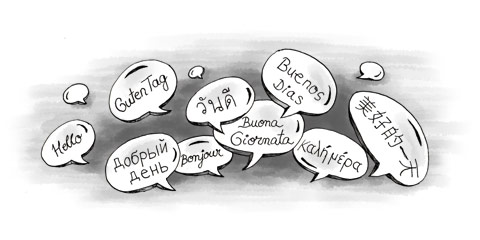Thai (ภาษาไทย) is mainly spoken in Thailand, along with the Midway Islands, Singapore, the UAE and the USA. Other languages spoken in Thailand include Chinese, Lao, Khmer (Cambodian) and Malay.
The Tai-Kadai language family includes Thai and Lao - the national languages of Thailand and Laos. Both languages are tonal and analytic. Tonal languages use tones to distinguish words and analytic languages compose words of single morphemes. However, many words in the Thai language are from Pali (one of the earliest Buddhist scriptures), Sanskrit and the old Cambodian language (old Khmer).
Along with the regional dialects, there are also several other ways of speaking the Thai language:
- Spoken Thai or street Thai – an informal way of speaking without polite terms of address. Used between close relatives and friends.
- Written Thai or elegant Thai – a formal way of speaking that uses polite terms. A simplified form is used in newspapers.
- Rhetorical Thai – used mainly for public speeches.
- Religious Thai – used when addressing monks or talking about Buddhism.
- Royal Thai – used when addressing or talking about the royal family.
Although street Thai and elegant Thai are the most common ways of speaking, most Thai people can speak in many different ways. Religious and royal Thai are taught in schools as part of the national curriculum.
In Thailand, polite and charming talk can get you much further than by just being assertive. In general social conversations, there are many different ways of saying the same thing. Choose your words wisely and speak sensitively and you will find it makes a big difference when talking to Thai people.
Learning Thai
Most foreigners that can speak Thai cannot read or write it at all. Some people can also speak a little Thai, which they have learned on the street.
If you want to speak Thai in an office environment and gain people’s respect, you should familiarise yourself with the differences between regional dialects. Many girls who entertain foreigners tend to speak with a northern accent. If you learn this way of speaking and use it in your office environment, it won’t be very advantageous for you.
The Thai alphabet and grammar
Thai is a complex language with five different tones and a syllabic alphabet consisting of 44 basic consonants. Consonants are divided into three classes: green, red and blue, which help to determine the tone of a syllable.
There are only eight possible consonants that a word in Thai may end with: p,t,k,m,n,ng,w and y. So when Thai speak other languages, they have trouble with words that end in other consonants/sounds.
Many Thai words can be used as adverbs, adjectives, nouns or verbs, and the meaning differs depending on the tone. Each word has a tone, which can be high, low, rising, falling, up-down or down-up. If you change the tone, you will change the meaning of the word. The word “mai” for instance can mean “new”, “silk” or ”burn”. A good example of how the tone can change the meaning is the well-known tongue-twister in the Thai language - ไหมใหม่ไหม้มั้ย /mǎi mài mâi mái/ ("Does new silk burn?"). The word is the same, it has just been pronounced differently.
Westerners usually use tones for emphasis. In Thailand you will have to forget about this habit as this could make you even more incomprehensible.

